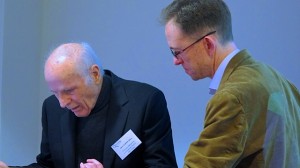This workshop, held on 31st March 2014 at the Innovation Centre, University of Exeter, made a fruitful contribution to our exploration of the long-term cultural legacy of facial disfigurement. In underlining the close links between the face and the passions and studying their representations in past and contemporary works, participants tackled questions that lie at the heart of the 1914 FACES 2014 project, such as the expressivity of the faces of First World War disfigured combatants and the perceptions and artistic depictions of disfigurement since the medieval period.
A key concern throughout the day was the legacy of Duchenne de Boulogne and the enduring influence of the idea of the passions in contemporary representations of the face. The starting-point for this dialogue was François Delaporte’s paper, ‘La Fabrique du visage et des passions’. Drawing upon Professor Delaporte’s landmark publications in the field, including L’Anatomie des passions (2003), the paper addressed the revolutionary influence of Duchenne, not only transforming understandings of the muscle physiology of the face, but also leading to repercussions in numerous other fields including medicine, art, literature, cinema and philosophy. The session was chaired by Professor Bernard Devauchelle, and led into a round table featuring François Delaporte, Bernard Devauchelle and the maxillo-facial surgeon Professor Iain Hutchison (St Bartholomew’s). The session identified numerous avenues for further discussion, and informed the consideration of modern and contemporary treatments of the face in philosophy and the arts later in the day. The second paper, by Julie Mazaleigue, discussed the representation of sexual desire, including representations of bodily dysmorphia, with special reference to the face and the gaze. The enquiry stretched from Franz von Bayros’ controversial illustrations of the nineteenth century all the way through to twenty-first century cinema. Alex Murray’s paper then questioned whether the face can be considered as biopolitical, assessing the brief analysis of the face in Agamben’s work and considering its articulation in technologies of security and surveillance. Joe Kember focussed on Harry Langdon’s facial performances in silent cinema of the early twentieth century. An exploration of facial grotesquery, the non-expressive face and the allegorical meaning of the face in silent cinema culminated in an analysis of the face in short silent film clips. David Houston Jones, meanwhile, discussed the enigma of the expressive and inexpressive face in the work of Samuel Beckett and the French photographer Luc Delahaye, considering Delahaye’s debt to Walker Evans and documentary traditions while also subverting contemporary and historical norms concerning the visual representation of the face. The final paper of the day came from Professor Patricia Skinner, who gave a cutting-edge account of the medieval face and the iconographical traditions which underlie it. In particular, Skinner’s paper considered the relationship of the passions to the deadly sins: love, pain, fear and anger and the pathological understanding of those states. Skinner assessed the diagnostic value of physiognomy texts – associating facial features with character traits and behavioural tendencies – frequently bound together with collections of medical texts after the 13th century.
Accompanying the workshop was a selection of artworks by Justin Jones, curated by Cristina Burke-Trees, ahead of the upcoming Faces of Conflict exhibition beginning in January 2015 at RAMM. Jones’s work draws upon two key strands of 1914FACES2014: the facially injured soldiers of the first world war, and the Passions, the theme of today’s workshop.
